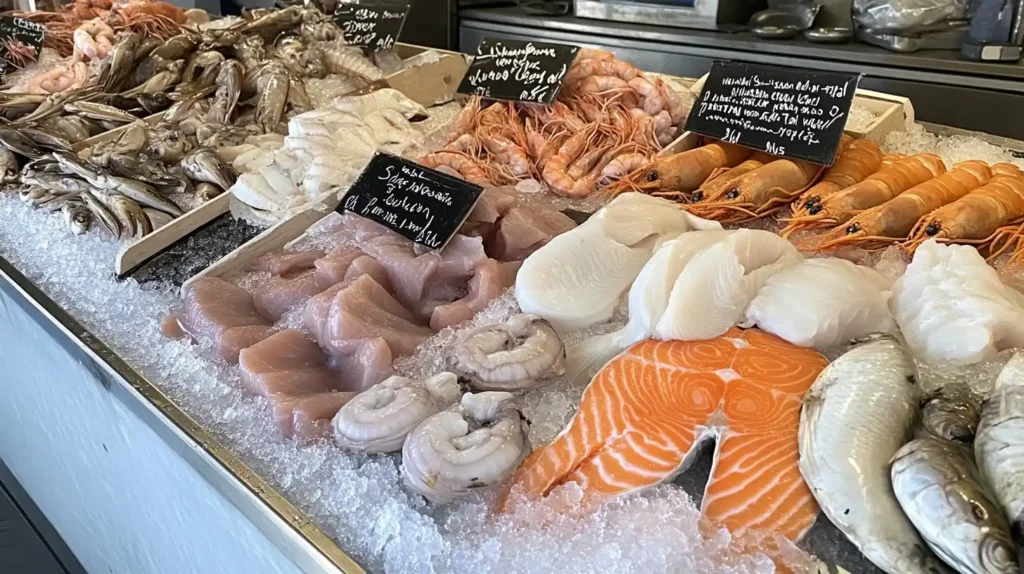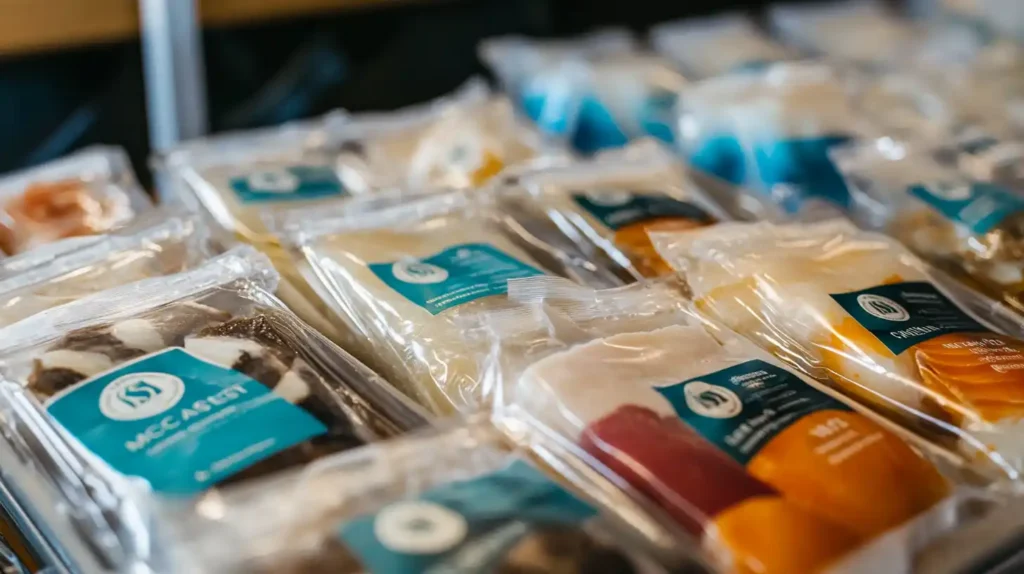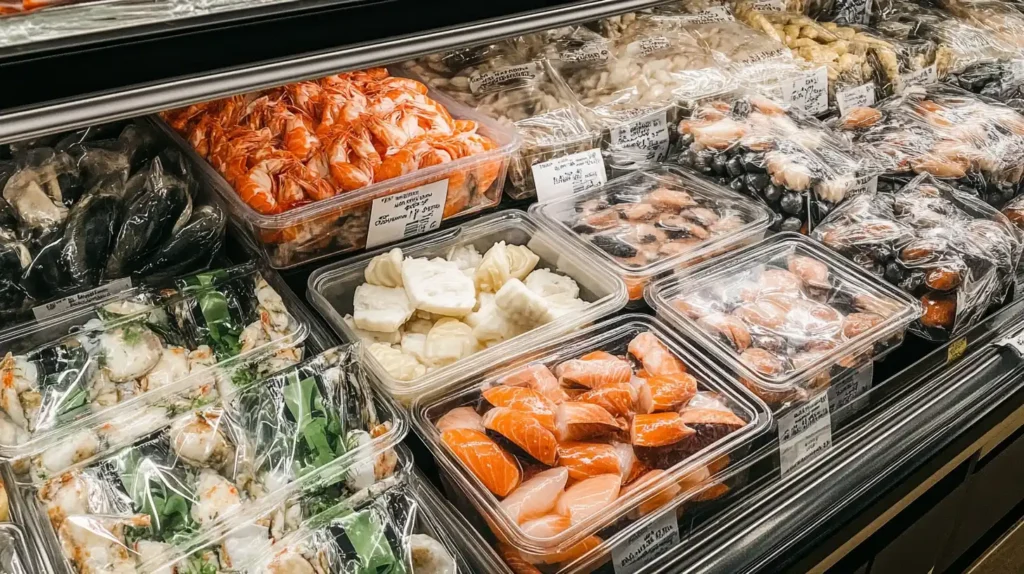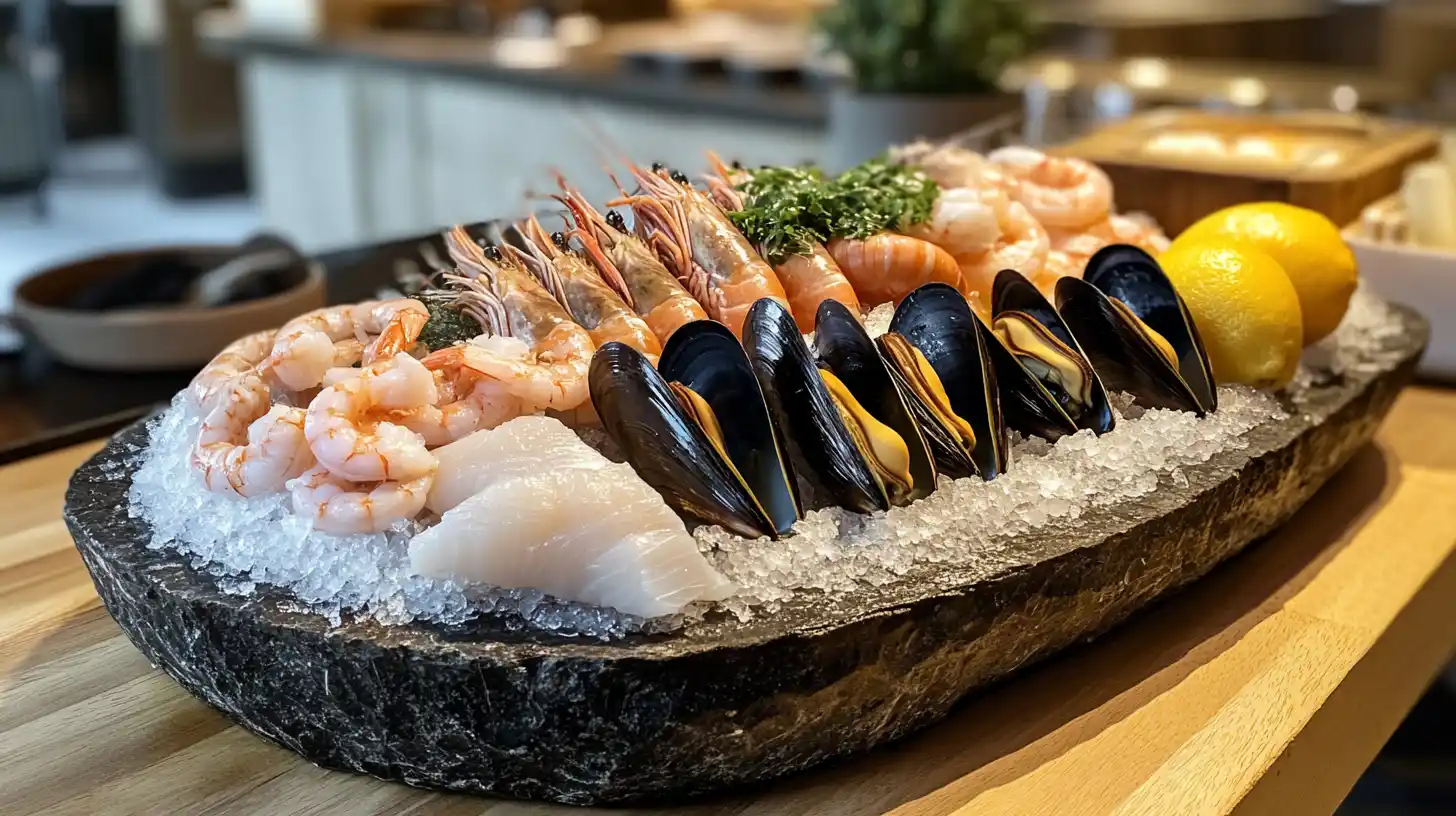Seafood mix is a combination of various seafood types, commonly used in soups, pasta, stir-fries, and rice dishes. But have you ever wondered exactly what fish is in seafood mix? Understanding the ingredients can help you choose the best mix, cook it properly, and create delicious meals.
If you’re looking for a broader overview, check out this comprehensive guide on seafood mix, which provides detailed insights into its composition and uses.
This guide will help you:
- Identify the types of fish in seafood mix
- Choose the best quality seafood mix
- Cook seafood mix using the best methods
Table of contents

Understanding Seafood Mix
Seafood mix is a pre-packaged combination of different seafood types, usually including fish, shellfish, and mollusks. It is a convenient option for home cooks who want to prepare seafood dishes without buying multiple ingredients separately. Since it provides a variety of flavors and textures, seafood mix is a great choice for many recipes.
What’s Included in a Typical Seafood Blend?
Different brands and regions offer various seafood mixes, each designed for specific cooking styles. Some contain only fish, while others include a mix of fish, shrimp, mussels, squid, and scallops. Here are the most common types:
- Standard seafood mix – Typically includes white fish, shrimp, mussels, squid, and scallops.
- Deluxe seafood mix – Often contains lobster, crab meat, or larger scallops for a premium selection.
- Asian seafood mix – Usually features squid rings, imitation crab, and small shrimp, ideal for stir-fries and soups.
- Mediterranean seafood mix – Commonly includes white fish, calamari, shrimp, and mussels, perfect for paella and pasta.
Why is Seafood Mix Popular?
Many people choose seafood mix because it is versatile, time-saving, and cost-effective. It works well in a variety of dishes, making meal preparation easier. Here are some of the most popular uses:
- Paella – A traditional Spanish dish that combines rice, spices, and seafood.
- Seafood pasta – Perfect for creamy sauces or tomato-based recipes.
- Soups and stews – Enhances the broth with a rich seafood flavor.
- Stir-fries – Cooks quickly and pairs well with vegetables.
- Fried seafood – Can be coated in batter and fried for a crispy texture.
Since seafood mix contains different seafood varieties, it can create a well-balanced flavor profile in dishes. Instead of buying multiple types of seafood, using a pre-mixed option simplifies cooking while maintaining high quality.
How is Seafood Mix Sold?
You can find seafood mix in fresh or frozen form, depending on your needs. Both options have advantages, so choosing the right one depends on how soon you plan to cook.
- Fresh seafood mix – Found at fish markets and premium grocery stores. Since it contains freshly cut seafood, it must be used within a few days.
- Frozen seafood mix – Available in most supermarkets. This version is pre-cleaned, portioned, and ready to cook. Because it has a longer shelf life, it is convenient for busy home cooks.
If you prefer fresh seafood mix, always check for bright colors, firm texture, and a clean ocean smell. For frozen options, avoid packages with excessive ice crystals, as they may indicate freezer burn.
Sustainability in Seafood Mix
Since overfishing is a growing concern, choosing sustainable seafood helps protect marine ecosystems. To ensure responsible sourcing, look for certifications such as:
- MSC (Marine Stewardship Council) – Verifies sustainable fishing practices.
- ASC (Aquaculture Stewardship Council) – Ensures responsible fish farming.
- BAP (Best Aquaculture Practices) – Focuses on ethical seafood production.
By selecting sustainably sourced seafood mix, you can enjoy delicious meals while contributing to ocean conservation.

What Fish is in Seafood Mix?
Seafood mix contains a variety of seafood types, carefully selected to create a balanced blend of flavors and textures. The exact combination may vary by brand or region, but most seafood mixes include white fish, shellfish, and mollusks. Understanding the ingredients can help you choose the right mix for your recipes.
1. White Fish in Seafood Mix
White fish is a staple in seafood mix because of its mild flavor and firm texture. It blends well with other seafood and absorbs seasonings effectively. Some of the most common types found in seafood mixes are:
- Cod – A firm, mild fish that works well in soups and stews.
- Haddock – Slightly sweet and softer than cod, making it ideal for frying.
- Pollock – A budget-friendly white fish, often used in frozen seafood mixes.
- Tilapia – Light and flaky, great for pan-fried and sautéed dishes.
- Hake – A mild, slightly sweet fish popular in Mediterranean cuisine.
Since white fish has a neutral taste, it pairs well with a variety of seasonings and cooking methods.
2. Common Fish and Shellfish Found in Mixed Seafood
Shellfish add a rich, briny taste to seafood mixes, enhancing the overall flavor. Some of the most common shellfish included are:
- Shrimp – A favorite for stir-fries, pasta, and soups. It cooks quickly and absorbs sauces well.
- Mussels – Brings a deep oceanic flavor to broths, stews, and rice dishes.
- Clams – A chewy seafood often used in pasta and creamy chowders.
- Scallops – Sweet and tender, perfect for searing or adding to sauces.
Because shellfish offer a unique taste and texture, they contribute depth to seafood dishes.
3. Squid & Octopus in Seafood Mix
Squid and octopus are often included in seafood mixes because of their slightly chewy texture and delicate flavor. They are commonly found in:
- Grilled seafood platters
- Seafood pasta and risotto
- Paella and Mediterranean dishes
Since squid and octopus cook quickly, they require careful preparation to avoid becoming rubbery.
4. Imitation Seafood in Seafood Mix
Some frozen seafood mixes include surimi, a processed fish product made to resemble crab or lobster. If you prefer an all-natural seafood mix, always check the ingredient list before purchasing.
Regional Takes on Mixed Seafood
Seafood mix varies by region, as different cultures use unique seafood combinations to match their traditional dishes. While some mixes focus on white fish and shellfish, others include regional specialties like squid, octopus, or imitation crab. Understanding these differences can help you choose the best mix for your favorite recipes.
1. Mediterranean Seafood Mix
Mediterranean cuisine features bold flavors and a strong emphasis on fresh seafood. A typical Mediterranean seafood mix contains:
- White fish – Often hake, cod, or sea bass
- Calamari (squid rings) – Common in paella and seafood pasta
- Mussels and clams – Used in rich broths and sauces
- Shrimp – A staple in grilled and sautéed seafood dishes
This mix is perfect for paella, seafood pasta, and grilled seafood platters. Mediterranean dishes often use olive oil, garlic, lemon, and fresh herbs to enhance the seafood’s natural flavor.
2. Asian Seafood Mix
Asian seafood mixes tend to include a variety of shellfish and squid, often used in stir-fries, soups, and noodle dishes. A typical mix may contain:
- Squid rings – Common in stir-fries and soups
- Shrimp – Used in curries, noodles, and dumplings
- Imitation crab (surimi) – Popular in sushi rolls and seafood salads
- Scallops – Added to seafood stir-fries and fried rice
Asian cuisine often features ginger, soy sauce, sesame oil, and chili to bring out the seafood’s flavors. Many frozen seafood mixes cater to Japanese, Chinese, Thai, and Korean cooking styles.
3. How Different Cultures Customize Their Seafood Blends
In the United States, seafood mixes often focus on classic American seafood dishes like chowders, pasta, and seafood boils. A typical American seafood blend includes:
- Shrimp – Used in Cajun-style seafood boils and creamy pasta
- Clams and mussels – Found in seafood stews and clam chowder
- Scallops – A key ingredient in pasta and pan-seared seafood dishes
- Lobster (in premium blends) – Used in bisques and seafood mac and cheese
American-style seafood dishes often feature butter, garlic, and cream-based sauces, making them rich and flavorful.
4. Latin American Seafood Mix
Latin American cuisine has a strong emphasis on fresh seafood, especially in coastal regions. A typical Latin American seafood mix includes:
- White fish (tilapia, snapper, or mahi-mahi) – Used in ceviche and grilled dishes
- Shrimp – Found in seafood cocktails and garlic shrimp dishes
- Squid – Common in rice dishes and stews
- Clams and mussels – Often cooked in tomato-based sauces
Latin American seafood dishes frequently use lime juice, cilantro, tomatoes, and spicy peppers, creating bold and zesty flavors.
Buying and Storing Seafood Mix
Seafood mix is available in different packaging options, depending on the brand and where you buy it. The two main types are fresh seafood mix and frozen seafood mix. Each has its advantages, depending on how soon you plan to use it and the type of dish you want to prepare.

1. Packaging Types and Where to Find Them
Fresh seafood mix is usually sold at seafood markets or grocery store fish counters. It contains freshly cut seafood, making it an excellent choice for those who prefer the best texture and flavor.
Advantages of Fresh Seafood Mix:
- Higher quality and better texture than frozen options
- No preservatives or artificial additives
- Ideal for dishes where seafood must be cooked quickly, such as ceviche or pan-seared recipes
Disadvantages of Fresh Seafood Mix:
- Short shelf life – Needs to be cooked within 1-2 days
- May not always be available, depending on season and location
- Can be more expensive than frozen seafood mix
2. How to Keep Seafood Fresh for Longer
Frozen seafood mix is pre-cleaned, portioned, and ready to cook. It is widely available in supermarkets, making it a convenient choice for home cooks.
Advantages of Frozen Seafood Mix:
- Long shelf life – Can be stored for several months
- More affordable than fresh seafood
- Easy to use – No cleaning or prep work required
- Available year-round, regardless of seafood seasonality
Disadvantages of Frozen Seafood Mix:
- Texture may be slightly softer after thawing
- Some brands add preservatives or use lower-quality seafood
- Requires thawing before cooking in certain dishes
How to Choose the Best Seafood Mix
Whether you prefer fresh or frozen seafood mix, here are some tips to ensure you buy the best quality:
- For fresh seafood mix:
- Look for bright colors and firm textures
- Avoid seafood with a strong fishy smell (it should smell like the ocean)
- Check for clear eyes and moist flesh if whole seafood is included
- For frozen seafood mix:
- Avoid packaging with too many ice crystals, as this could indicate freezer burn
- Check the ingredient list for additives or preservatives
- Look for brands that mention wild-caught or sustainably sourced seafood
If sustainability is important to you, choose seafood mix with MSC (Marine Stewardship Council) or ASC (Aquaculture Stewardship Council) certifications. These labels indicate that the seafood is ethically and responsibly sourced.
Cooking Tips for Seafood Blends
Cooking seafood mix correctly enhances its natural flavors. Some of the best methods include:
- Sautéing – A quick and flavorful option; simply cook in garlic butter for 5-7 minutes.
- Grilling – Skewering the seafood adds a smoky, charred taste.
- Steaming – Preserves nutrients while keeping the seafood tender.
- Boiling – Works well for soups, stews, and seafood boils.
- Frying – Lightly battered seafood turns crispy and delicious.
When preparing seafood mix, timing is crucial. Overcooked shellfish and squid tend to become rubbery, so monitor cooking times carefully.
Health Benefits of Eating Seafood
Consuming seafood mix offers a range of health benefits:
High in protein – Supports muscle growth and recovery.
Rich in Omega-3 fatty acids – Promotes brain and heart health.
Low in calories – A nutritious alternative to red meat.
Packed with vitamins & minerals – Contains Zinc, Iodine, and Vitamin B12.
Choosing Quality Seafood Mix
Selecting a high-quality seafood mix ensures better taste and sustainability. Consider the following:
- Opt for sustainable seafood – Look for MSC-certified products.
- Examine labels – Avoid additives like sodium tripolyphosphate.
- Choose wild-caught seafood – Often healthier and more flavorful than farmed options.
By making informed choices, you can enjoy delicious seafood while supporting ethical fishing practices.
Frequently Asked Questions
Which Fish Are Most Common in Seafood Mix?
Most seafood mixes contain white fish (cod, haddock, pollock, tilapia), along with shrimp, squid, mussels, and scallops.
Is Pre-Packaged Seafood Already Cooked?
Not usually. Most seafood mixes come raw and require cooking before consumption.
Can I Create a Custom Seafood Blend?
Absolutely! You can create your own mix by selecting your favorite seafood and adjusting portions to your liking.
How Do You Properly Thaw Frozen Seafood?
For best results, thaw overnight in the refrigerator or use a cold water bath for faster defrosting.
What Causes a Strong Odor in Seafood?
A strong odor may indicate poor freshness. Always check the expiration date and inspect the seafood before cooking.
Is Seafood Mix Safe for Those with Allergies?
No. Most seafood mixes contain shrimp, mussels, and clams, which are common allergens.
Can I Make My Own Seafood Blend at Home?
Yes! Simply combine your preferred fresh seafood and store it in the fridge or freezer.
Final Thoughts on Seafood Mix
Seafood mix is a versatile and healthy ingredient that allows you to enjoy multiple seafood flavors in one dish. Whether you prefer a Mediterranean seafood mix for pasta or an Asian-style mix for stir-fries, understanding what fish is in seafood mix helps you make informed choices.
If you’re interested in more seafood-related dishes, you might enjoy delicious spaghettini pasta recipes, which pair perfectly with a seafood mix.
By selecting high-quality, sustainable seafood, you can enjoy fresh flavors while supporting ethical fishing practices. Next time you’re grocery shopping, pick up a pack of seafood mix and try a new recipe!

